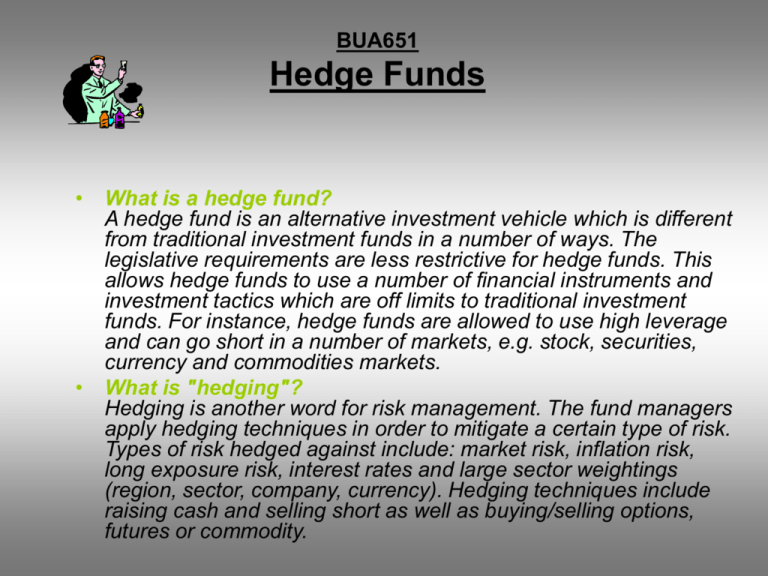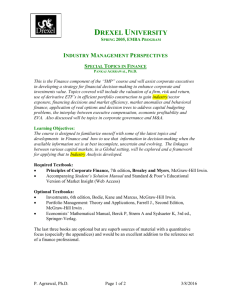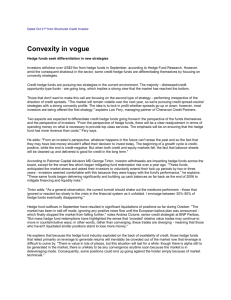Hedge Fund Strategies
advertisement

BUA651 Hedge Funds • What is a hedge fund? A hedge fund is an alternative investment vehicle which is different from traditional investment funds in a number of ways. The legislative requirements are less restrictive for hedge funds. This allows hedge funds to use a number of financial instruments and investment tactics which are off limits to traditional investment funds. For instance, hedge funds are allowed to use high leverage and can go short in a number of markets, e.g. stock, securities, currency and commodities markets. • What is "hedging"? Hedging is another word for risk management. The fund managers apply hedging techniques in order to mitigate a certain type of risk. Types of risk hedged against include: market risk, inflation risk, long exposure risk, interest rates and large sector weightings (region, sector, company, currency). Hedging techniques include raising cash and selling short as well as buying/selling options, futures or commodity. Hedge Fund Strategies • Merger Arbitrage - an event-driven strategy in which the arbitrageur takes a position of both companies involved in a merger or acquisition, typically long the stock of the company being acquired and short the stock of the acquirer. • Fixed Income Arbitrage - a strategy designed to capture pricing disparities within fixed income markets and related derivatives. Examples of where such disparities may exist are yield curve anomalies, volatility differences and the futures market versus the underlying bonds. • Global Macro - a broad strategy that invests (long or short) across asset classes in anticipation of market movements or trends in interest rates, currencies, commodity prices and equity markets. Hedge Fund Strategies • Convertible Arbitrage - a strategy designed to take advantage of pricing inefficiencies of the embedded option in a convertible bond. Typically, the arbitrageur would be long the convertible position and short the underlying stock. • Equity Market Neutral - a strategy designed to exploit equity price inefficiencies through balanced long and short positions that insulate the portfolio from overall market risk. • Long/Short - the most common hedge fund strategy in which a manager takes long and short equity positions. Depending on the mix of long and short positions the portfolio may have a long bias or short bias. Hedge Funds QA • What are some ‘short sale’ intricacies? When a broker facilitates the delivery of a client's short sale, the client is charged a fee for this service, usually a standard commission similar to that of purchasing a similar security. If the short position begins to move against you (rise in price), money will be removed from your cash account and moved to your margin account. If short shares continue to rise in price, and you don't have enough funds in your cash account to cover the position, you'll begin to borrow on margin for this purpose. At that time, you'll also begin to accrue margin interest charges. These will be computed and charged the same as for a regular margin debit. When short selling a stock that pays dividends and the ex-dividend date passes while you are short the stock, the dividend will be deducted from your account. It should also be noted that contrary to standard finance theory, the short seller often does not enjoy the benefits of the proceeds of the short sale to earn interest or reduce outstanding margin amounts. The brokers generally do not pass this benefit on to the retail client, unless the client is very large. Hedge Funds QA • • • • • • Are all hedge funds aggressive risk takers? No, a number of hedge funds, particularly in recent years as institutional investors have entered the hedge fund investment business focusing exclusively on generating stable, consistent returns by employing low risk investment strategies. What are hurdle rates? The minimum investment return a fund must generate before it is eligible to take a performance allocation or an incentive fee. What are lock-up periods? The amount of time during which assets cannot be removed from the hedge fund. Who typically invest in hedge funds? Pension funds, insurance companies, fund of funds, endowments and qualified clients. http://www.hedgenordic.com/?pageid=47 http://www.commonfund.org/Commonfund/Help/Glossary.htm#pcm Hedge Fund project – some specifics • 1. This is a market-neutral paper portfolio exercise, for illustration of investment and modern portfolio theory concepts. It is not to be construed as investment advice of any sorts, I am not a financial planner. • 2. Buying a Short ETF is a short and not a long, will you hedge it with another short on the short side? Also a short ETF/Fund has a higher expense ratio, remember you are the investment pro in the making, you do not want a pro to do your work. No mutual funds in the portfolio as well, except CE funds and only if there are no comparable ETF’s – such as IRL or IFN • 3. You do not need equal number of securities on each side, strive for beta neutrality, but you must have $ neutrality at the very least. If you have a stock only long portfolio - about 16-20 stocks is necessary for minimal diversification. If you have ETFs you can have fewer on each side. Hedge Fund project – some specifics • 4. Shares are traded in 'round lots' , which are multiples of 100 (most of the times). Anything else will incur higher trading costs or may not be feasible. Minor deviations around total portfolio value are expected and not a problem. Multiples of 10 are OK for this project. • 5. Beta-non stationarity' problem – betas are being calculated differently by the different sites? Simple solution for now - use betas from a single source - since different providers use varying assumptions about how to calculate it. Cross-check the ETF betas with those from my XL sheet, the website that has numbers closest to mine is doing a better job, then go with them. You can read my latest paper on ETF betas that discusses this. • 6. You cannot invest in indices – they are non-investible – an instrument has to have a bid-ask for it to be tradeable, for example ^ATDOW is the Austria index (non-tradeable), use EWO to trade/track it. The Euro such as ^DJEURO is an index – FXE is the associated index. iShares.com, Yahoo ETF sites list ETF’s by type. Hedge Fund project – some specifics • • • • • 7. Fund expenses: The ultimate objective of this project is to simulate real market conditions that impact investor bottom line. When you calculate your net return at the end of semester a higher ETF fee will eat into your gross return. So you make the call. http://funds.reuters.com/lipper/retail/reuters/expenses.asp http://finance.yahoo.com/q/pr?s=spy http://www.ishares.com/fund_info/all_funds_profile.jhtml 8. Various market betas: Since you are a US investor keep it simple at SP500 (SPY) as the relevant market...most other securities in your portfolio have US market betas. Hedge Fund project – some weblinks • • • • • • • • • • • • • • A good primer on ETF's http://finance.yahoo.com/etf/education http://www.ishares.com/learn/index.jhtml http://amex.com/ (click on ETF's) • • • About fund expenses: http://quicktake.morningstar.com/DataDefs/FundNutsAndBolts.html http://funds.reuters.com/lipper/retail/reuters/expenses.asp Other ETF resources: http://www.etfconnect.com/ http://www.etftopics.com/sitemap/ http://www.currencyshares.com/ http://etfscreen.com/ For the ETF correlation and beta matrices : http://advancedportfoliosolutions.com/aps-research.html http://www.sectorspdr.com/correlation/






